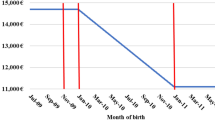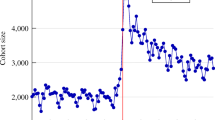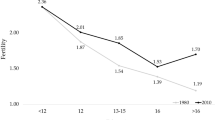Abstract
An explicit goal of policymakers in drafting welfare reform policies was to reduce incentives for nonmarital childbearing. This paper estimates the extent to which state welfare reforms have lowered age and race-specific nonmarital fertility. Using state-level data from 1984 to 1999—a time period that includes the passage and implementation of national welfare reform—we estimate fixed effects models corrected for heteroscedasticity and autocorrelation. We find evidence that the family cap, a policy that decreases or eliminates the incremental increase in benefits for mothers who have an additional child while on welfare, is associated with a decline in nonmarital birth ratios. However, we also find that the family cap is associated with higher marital birth rates. Taken together with other research, our findings suggest evidence of policy endogeneity.
Similar content being viewed by others
Notes
States that either did not apply for approval or did not receive approval on their application were: Alaska, Kentucky, Nevada, New Mexico, and Rhode Island.
States that did not implement the waivers prior to August, 1996 were: D.C., Idaho, Kansas, Louisiana, Maine, South Carolina, and Tennessee. These states then either implemented them under the new Temporary Assistance to Needy Families (TANF) laws or rewrote them.
We also used a third definition of the dependent variable—the proportion of single women in the population with a nonmarital birth, where the proportion of single women is estimated using state-specific marriage rates from the Current Population Survey (CPS). However, the denominator is endogenous and difficult to measure. Regression results using this definition of the dependent variable are not reported here, but are similar to the findings in the regression using the “nonmarital birth rate” as defined above.
Values of the ratio and rate that are 0 or 1 for at least one age and race group are excluded from the entire analysis for consistency. Twenty-two observations are excluded: Maine, 1992, 1997, 1999; Vermont, 1985, 1987, 1989–1991, 1993, 1994, 1996–1999; New Hampshire, 1994, 1999; North Dakota, 1989; South Dakota, 1997; Idaho, 1990; Wyoming, 1989, 1993; and Montana 1999.
We included both lagged and unlagged values for several variables in order to capture the 9-month lag associated with childbearing as well as decisions made after conception such as pregnancy resolution and marriage decisions. Lagged values were not included when the correlation between lagged and contemporaneous values was greater than 0.8 nor for variables calculated as a 3-year moving average. An F-test shows that the included lagged variables contribute to the model in the post-teen regressions but not in the teen regressions.
The welfare policy data in this paper differ from data used by the Council of Economic Advisers [CEA] (1997) in several regards. First, while in its most recent report the CEA does take into account the implementation date of policies it does not account for their scope within each state. The CEA data only include welfare reform policies that were implemented statewide. We interviewed officials from many states in order to collect accurate data about the statewide scope of implementation. Therefore we consider a more complete set of welfare reform policies because we include policies that were not implemented statewide. Second, the CEA classifies the welfare reform policies into six categories: termination of time limits, work requirement time limits, family caps, JOBS exemptions, JOBS sanctions and the earnings disregard. Our classification differs somewhat because we explicitly include more welfare reform policies hypothesized to have an impact on nonmarital fertility decisions. Alternate specifications that have used the CEA definitions of waivers produce qualitatively similar results to those presented here (see Sabia 2006)
To make the measurement of each welfare reform policy precise, the scope and time frame of request and implementation are taken into account in the coding. Thus the welfare reform variables are not constrained to be either 0 or 1; rather, they represent a proportion between 0 and 1 (inclusive of the end points). The equation for the welfare reform policy variables is: dt,s = pt,s*at,s, where d is an indicator of the presence of the policy in year t and state s; and pt,s is the proportion of the year that the policy is in place, and at,s is the proportion of the population in the state in the area in which the policy is implemented. If the economic constraints imposed by the program are what matter for behavior, we would expect only implementation dates to have a significant effect on nonmarital fertility. However, the announcement of and discussion about the intended policy changes heighten public awareness and may result in response to the proposed policies before actual implementation (e.g., an advertising effect). In this case one could expect the request or approval dates to be correlated with the dependent variable. In order to account for this possibility, our models include two separate variables for each of the seven welfare policies. The request date is the date that the state sent the proposed demonstration project to DHHS for approval. This variable is turned on only for the years in which the waiver to implement the policy had been requested and prior to the year it was actually implemented. The implementation date is, to the best knowledge of DHHS, the date when the policies were instituted statewide or in the entire area intended by the demonstration project. This variable is set to zero in all years prior to the year in which the particular policy was implemented.
The magnitudes we report in this section are based on the marginal effects presented in Appendix A1.
In a previous paper we decompose the change in nonmarital birth ratios between 1987 and 1996 into the effects attributable to changes in: (1) demographic and economic variables, (2) welfare reform policies, and (3) the time effect (Horvath-Rose and Peters 2001). The decomposition showed that the actual increase in predicted nonmarital birth ratios is attributable primarily to unobserved time effects captured by time dummies. We found that, relative to unexplained time trends, policy variables have a small overall effect on changes in nonmarital birth ratios. However, it is important to note that policy measures could have an indirect impact on nonmarital childbearing by affecting the socioeconomic characteristics of the population, for example, through education policies and by affecting attitudes that are reflected in the time trend.
References
Abramovitz, M. (2001). A triple whammy for the poor: The combined impact of welfare reform, the recession, and the World Trade Center attack. National Association of Social Workers, NYC Chapter, Hunter College School of Social Work, New York NY. Retrieved from http://www.naswnyc.org/w21.html.
Acs, G. (1994). The impact of AFDC on young women’s childbearing decisions. Mimeograph. Washington D.C.: The Urban Institute.
Acs, G. (1996). The impact of welfare on young mothers’ subsequent childbearing decisions. The Journal of Human Resources, 31(4), 898–915.
An, C.-B., Haveman, R., & Wolfe, B. (1993). Teen out-of-wedlock births and welfare receipt: The role of childhood events and economic circumstances. The Review of Economics and Statistics, 75(2), 195–208.
Anderson, E. (1989). Sex codes and family life among poor inner-city youths. Annals of the American Academy of Political and Social Science, 501, 501:59–78.
Argys, L. M., Averett, S. L., & Rees, D. I. (2000). Welfare generosity, pregnancies and abortions among unmarried AFDC recipients. Journal of Population Economics, 13, 569–594.
Bachu, A. (1993). Fertility of American women: June 1992. Current population reports, Series P–20, No. 470. Washington D.C.: U.S. Government Printing Office.
Bertrand, M., Duflo, E., & Mullainathan, S. (2002). How much should we trust differences in differences estimates? NBER Working Paper No. 8841, March.
Billy, J., & Moore, D. (1992). A multilevel analysis of marital and nonmarital fertility in the U.S. Social Forces, 70, 977–1011.
Blank, R. (1997). It takes a nation: A new agenda for fighting poverty. Princeton NJ: Princeton University Press.
Blank, R., George, C. C., & London, R. A. (1996). State abortion rates: The impact of policies, providers, demographics, and economic environment. Journal of Health Economics, 15(4), 513–553.
Brewster, K. (1994). Neighborhood context and the transition to sexual activity among young black women. Demography, 31(4), 603–614.
Camasso, M. J., Harvey, C., Jagannathan, R., & Killingsworth, M. (1998). A final report on the impact of New Jersey’s family development program, experimental-control group analysis. New Brunswick NJ: Rutgers University School of Social Work.
Council of Economic Advisers. (1997). Explaining the decline in welfare receipt, 1993–1996. The White House.
Council of Economic Advisers. (1999). The effects of welfare policy and the economic expansion on welfare caseloads: An update. Unpublished paper, The White House.
Duncan, G. J. (1995). How nonmarital childbearing is affected by neighborhoods, marital opportunities, and labor market conditions. Report to Congress on out-of-wedlock childbearing. DHHS Publ. No. 95–1257. Hyattsville, MD: U.S. Department of Health and Human Services.
Duncan, G., & Hoffman, S. (1990a). Welfare benefits, economic opportunities, and out-of-wedlock births among black teenage girls. Demography, 27(4), 519–535.
Duncan, G., & Hoffman, S. (1990b). Welfare receipt and subsequent dependence among black adolescent mothers. Family Planning Perspectives, 22(1), 16–20.
Dyer, W. T., & Fairlie, R. W. (2001). Do family caps reduce out-of-wedlock births? Evidence from Arkansas, Georgia, Indiana, New Jersey, and Virginia. Manuscript, Department of Economics, University of California at Santa Cruz.
Elster, A., Pangarine, S., & McArney, E. (1980). Causes of adolescent pregnancy. Medical Aspects of Human Sexuality, 14, 14: 83–87.
Fairlie, R. W., & London, R. A. (1997). The effect of incremental benefits levels on births to AFDC recipients. Journal of Policy Analysis and Management, 16(4), 575–597.
Figlio, D., & Ziliak, J. (1998). Welfare reform, the business cycle, and the decline in AFDC caseloads. Paper prepared for presentation at the conference “Welfare Reform and the Macro-Economy,” November 19–20, 1998, Washington, DC.
Fitzgerald, J. M., & Ribar, D. C. (2001). The impact of welfare waivers on female headship decisions. Joint Center for Poverty Research, Northwestern University/University of Chicago, Working Paper 247.
Hayward, M. D., Grady, W. R., & Billy, J. O. G. (1992). The influence of socioeconomic status on adolescent pregnancy. Social Science Quarterly, 73, 750–772.
Hogan, D. P., & Kitagawa, E. M. (1985). The impact of social status, family structure, and neighborhood on the fertility of black adolescents. American Journal of Sociology, 90, 825–852.
Horvath-Rose, A. (2000). Welfare waivers and women’s nonmarital fertility decisions. Dissertation, Cornell University.
Horvath-Rose, A., & Peters, H. E. (2001). Welfare waivers and nonmarital childbearing. In G. Duncan & P. L. Chase-Lansdale (Eds.), For better or for worse: Welfare reform and the well-being of children and families (pp. 222–244). New York: Russell Sage Foundation.
Hudson, J. L. (2000). Welfare and subsequent childbearing: The potential impact of the family cap law. Paper presented at the annual meeting of the Association for Public Policy Analysis and Management. Seattle WA.
Jagannnathan, R., & Camasso, M. J. (2003). The racial and contextual conditioning of welfare reform on non-martial fertility: The impact of New Jersey’s family cap experiment. Journal of Marriage and the Family, 65, 52–71.
Joyce, T., Kaestner, R., & Korenman, S. (2004a). Welfare reform and non-marital fertility in the 1990’s: Evidence from birth records. Advances in Economic Analysis and Policy, 3(1), 1108–1143.
Joyce, T., Kaestner, R., Korenman, S., & Henshaw, S. (2004b). Family cap provisions and changes in births and abortions. Population Research and Policy Review, 23, 475–486.
Kearney, M. S. (2002). Is there an effect of incremental welfare benefits on fertility behavior? A look at the family cap. National Bureau of Economics. Working Paper 9093.
Levine, P. B. (2004). Abortion policy and the economics of fertility. Society, 41(4), 79–86.
Lichter, D. (1995). The retreat from marriage and the rise in nonmarital fertility. In Report to Congress on out of wedlock childbearing (pp. 137–146). DHHS, Public Health Service. DHHS Pub No. (PHS) 95–1257.
Mach, T. (2001). Measuring the impact of family caps on childbearing decisions. Department of Economics, Discussion Paper #00–04. SUNY Albany.
Moffitt, R. A. (Ed.). (1998). Welfare, the family, and reproductive behavior: Research perspectives. Washington, DC: National Academy Press.
Moore, K., Morrison, D., & Glei, D. (1995). Welfare and adolescent sex: The effects of family history, benefit levels, and community context. Journal of Family and Economic Issues, 16(2–3), 207–237.
O’Neill, J. (1994). Report concerning New Jersey’s Family Development Program. Mimeograph. Department of Economics, Baruch College, City University of New York.
Peffley, M., Hurwitz, J., & Sinderman, P. (1997). Racial stereotypes and whites’ political views of blacks in the context of welfare and crime. American Journal of Political Science, 41, 30–60.
Peters, H. E., Plotnick, R. D., & Jeong, S.-O. (2003). How will welfare reform affect family structure and childbearing decisions? In R. A. Gordon & H. Walberg (Eds.), Changing welfare (pp. 49–91). New York: Kluwer Academic/Plenum Publishers.
Plotnick, R. (1990). Welfare and out-of-wedlock childbearing: Evidence from the1980s. Journal of Marriage and the Family, 52, 735–746.
Sabia, J. J. (2006). Blacks and the family cap: Pregnancies, abortions, and spillovers. Journal of Population Economics (forthcoming).
Seccombe, K., James, D., & Battle Walters, K. (1998). ‘They think you ain’t much of nothing’: The social construction of the welfare mother. Journal of Marriage and the Family, 60, 849–865.
South, S. J., & Lloyd, K. M. (1992). Marriage opportunities and family formation: Further implications of imbalanced sex ratios. Journal of Marriage and the Family, 54, 440–451.
Turturro, C., Benda, B., & Turney, H. (1997). Arkansas welfare waiver demonstration project: Final report. Little Rock AR: University of Arkansas.
Ventura, S.J. (1995). Births to unmarried mothers: United States 1980–92. Vital Health Statistics 21(53). National Center for Health Statistics, Health Statistics, Hyattsville, Maryland.
Wallace, G. (2002). The effects of family caps on subsequent fertility decisions of welfare mothers. Paper presented at the Association for Public Policy and Management Annual Meeting, Dallas, November.
Wilson, W. J. (1987). The truly disadvantaged: The inner city, the underclass, and public policy. Chicago IL: University of Chicago Press.
Author information
Authors and Affiliations
Corresponding author
Appendix
Appendix
Rights and permissions
About this article
Cite this article
Horvath-Rose, A.E., Peters, H.E. & Sabia, J.J. Capping Kids: The Family Cap and Nonmarital Childbearing. Popul Res Policy Rev 27, 119–138 (2008). https://doi.org/10.1007/s11113-008-9076-7
Received:
Accepted:
Published:
Issue Date:
DOI: https://doi.org/10.1007/s11113-008-9076-7




